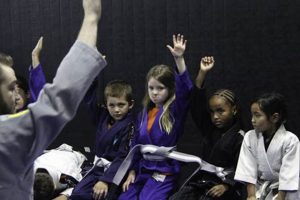Mixed martial arts training involves the development of skills across a range of combat disciplines, including striking, grappling, and wrestling. A typical session might encompass drills focusing on specific techniques like punches, kicks, takedowns, or submissions, alongside conditioning exercises to improve strength, speed, and endurance. Sparring, under controlled conditions, allows practitioners to apply these skills in simulated combat scenarios.
Consistent training sessions are essential for improving proficiency in mixed martial arts. Regular engagement builds muscle memory, enhances cardiovascular fitness, and develops strategic thinking crucial for success in the sport. Historically, the diverse nature of mixed martial arts has drawn from various combat traditions worldwide, gradually evolving into the formalized training methodologies practiced today. This evolution emphasizes not only physical prowess but also mental resilience and tactical awareness.
The following sections will delve deeper into specific aspects of mixed martial arts training, exploring the diverse methodologies employed and the benefits they offer to practitioners of all levels.
Tips for Effective Mixed Martial Arts Training
Maximizing the benefits of mixed martial arts training requires a disciplined and strategic approach. The following tips offer guidance for individuals seeking to improve their skills and overall performance.
Tip 1: Consistency is Key: Regular training sessions, even if short in duration, are more effective than sporadic intense workouts. A consistent schedule builds foundational skills and promotes long-term progress.
Tip 2: Prioritize Warm-ups and Cool-downs: Adequate warm-up prepares the body for strenuous activity, reducing the risk of injury. Cool-down routines aid in muscle recovery and flexibility.
Tip 3: Focus on Technique: Mastering proper technique is paramount, regardless of experience level. Refining fundamental movements improves efficiency and power.
Tip 4: Incorporate Strength and Conditioning: Strength training complements skill development by enhancing power and explosiveness. Conditioning exercises improve endurance and resilience.
Tip 5: Train with Different Partners: Exposure to diverse fighting styles and body types improves adaptability and provides a more realistic training experience.
Tip 6: Listen to Your Body: Rest and recovery are crucial for preventing overtraining and injury. Allow adequate time for the body to repair and rebuild.
Tip 7: Seek Professional Guidance: Experienced coaches provide valuable feedback and personalized instruction, accelerating skill development and minimizing the risk of errors.
Adherence to these guidelines promotes consistent growth, reduces the risk of injury, and cultivates a well-rounded approach to mixed martial arts training. Consistent effort and dedication are essential for achieving long-term goals and maximizing potential.
By understanding and implementing these principles, individuals can embark on a fulfilling journey of continuous improvement in mixed martial arts.
1. Skill Development
Skill development forms the cornerstone of effective mixed martial arts practice. Proficiency in various martial arts disciplines, including striking, grappling, and wrestling, is essential for competitive success. The development of these skills requires dedicated and consistent training, focusing on proper technique and execution. For instance, a fighter might dedicate specific sessions to refining their boxing combinations, improving takedown defense, or mastering Brazilian Jiu-Jitsu submissions. The deliberate practice of individual techniques translates into a more well-rounded and adaptable fighter. This targeted approach to skill acquisition allows practitioners to build a strong foundation, facilitating the seamless integration of techniques during sparring and competition.
The importance of skill development extends beyond individual techniques. It encompasses the ability to chain together movements fluidly, react instinctively to changing situations, and anticipate an opponent’s actions. A fighter with honed skills can effectively transition between striking and grappling, creating opportunities for offense and defense. For example, a fighter might use a well-timed jab to set up a takedown, or utilize a sprawl to defend against a wrestling attack. This dynamic interplay of skills is what distinguishes a skilled mixed martial artist from a novice. Furthermore, a deep understanding of technical nuances enables fighters to conserve energy, maximize efficiency, and minimize the risk of injury.
In conclusion, skill development is not merely a component of mixed martial arts practice; it is the very essence of the sport. Consistent and focused training, combined with a deep understanding of technical principles, enables fighters to reach their full potential. This pursuit of mastery, both in individual techniques and their integrated application, is what drives improvement and ultimately determines success in the competitive arena. The dedication to refining these skills forms the foundation upon which successful mixed martial arts careers are built.
2. Physical Conditioning
Physical conditioning represents a critical component of effective mixed martial arts practice. The demanding nature of the sport necessitates high levels of strength, power, endurance, and flexibility. A rigorous conditioning regimen directly influences a fighter’s ability to execute techniques, maintain offensive pressure, and withstand the physical rigors of competition. Cause and effect relationships are evident: improved cardiovascular fitness allows fighters to maintain a higher pace throughout a match, while enhanced strength facilitates powerful strikes and takedowns. For example, fighters with superior conditioning can effectively implement aggressive strategies late into a fight, capitalizing on an opponent’s fatigue. Conversely, inadequate conditioning can lead to diminished performance and increased vulnerability to injury.
Consider the practical significance of physical conditioning within mixed martial arts. A fighter with exceptional endurance can sustain a high output of strikes and grappling maneuvers, overwhelming an opponent through sheer volume. Similarly, explosive power translates to devastating knockout blows and forceful takedowns. Real-world examples abound: fighters renowned for their exceptional conditioning often dominate their opponents, demonstrating the undeniable link between physical preparedness and competitive success. Specific training modalities, such as high-intensity interval training (HIIT), plyometrics, and strength training, are commonly employed to enhance these physical attributes. The targeted development of these qualities enables fighters to withstand the grueling demands of training and competition, ultimately maximizing their potential within the sport.
In summary, physical conditioning is not merely an adjunct to mixed martial arts practice; it is an integral element of success. The development and maintenance of optimal physical attributes directly influence a fighter’s performance, resilience, and longevity within the sport. Challenges such as overtraining and inadequate recovery can hinder progress, highlighting the importance of a balanced and well-structured conditioning program. This understanding of the critical link between physical conditioning and performance provides a framework for effective training and competitive preparation in mixed martial arts.
3. Strategic Sparring
Strategic sparring serves as a critical bridge between theoretical technique and practical application within mixed martial arts practice. It provides a controlled environment for fighters to test their skills, develop tactical awareness, and refine their fighting style. Unlike casual sparring, which may focus on intensity or aggression, strategic sparring emphasizes the deliberate implementation of specific techniques and strategies. This nuanced approach fosters a deeper understanding of combat dynamics and accelerates the development of essential skills.
- Scenario-Based Training
Scenario-based training involves simulating specific fight situations, such as defending against a takedown or escaping a dominant position. This focused approach allows fighters to practice techniques under pressure, improving their reaction time and decision-making abilities. For example, a fighter might practice defending against a rear-naked choke or transitioning from guard to mount. These targeted simulations enhance a fighter’s ability to adapt to dynamic combat scenarios and effectively implement pre-determined strategies.
- Controlled Resistance
Controlled resistance involves sparring with a partner who offers a specific level of opposition, allowing fighters to focus on refining particular techniques or strategies. This approach differs from full-contact sparring, as it emphasizes technical precision and control over power and aggression. For instance, a fighter might practice their jab-cross combination against a partner who offers minimal resistance, allowing them to perfect their form and timing. This method allows for the isolated development of specific skills without the risk of injury associated with full-contact sparring.
- Analytical Feedback
Analytical feedback, provided by coaches or training partners, plays a vital role in strategic sparring. Constructive criticism and objective analysis of performance help fighters identify areas for improvement and refine their techniques. Post-sparring analysis might involve reviewing footage, discussing tactical decisions, or identifying recurring patterns. This feedback loop facilitates continuous improvement and allows fighters to address technical flaws and refine their strategic approach.
- Adaptive Strategy
Adaptive strategy in sparring involves adjusting one’s approach based on the opponent’s style and tendencies. This requires fighters to analyze their opponent’s strengths and weaknesses, anticipate their actions, and modify their tactics accordingly. For example, a fighter facing a strong wrestler might prioritize takedown defense and distance management. This dynamic approach to sparring encourages critical thinking, enhances tactical awareness, and prepares fighters for the unpredictable nature of real competition.
These interconnected facets of strategic sparring contribute significantly to overall development within mixed martial arts practice. By emphasizing deliberate practice, controlled resistance, analytical feedback, and adaptive strategy, fighters cultivate a more nuanced understanding of combat dynamics. This refined approach to training translates to improved performance, enhanced tactical awareness, and increased adaptability in the competitive arena. Strategic sparring, therefore, is not merely a component of training, but a crucial element in the ongoing pursuit of mastery in mixed martial arts.
4. Mental Fortitude
Mental fortitude constitutes a crucial element within mixed martial arts practice, significantly influencing performance and overall success. The demanding nature of the sport, characterized by intense physical exertion, strategic complexity, and inherent risk, necessitates a robust mental approach. Mental fortitude enables fighters to manage stress, maintain focus under pressure, and persevere through adversity. Cause and effect relationships are evident: strong mental fortitude allows fighters to overcome self-doubt, maintain composure during challenging exchanges, and effectively implement strategies amidst the chaos of combat. Conversely, a lack of mental resilience can lead to hesitation, diminished performance, and increased susceptibility to psychological manipulation by opponents. Real-world examples abound: fighters renowned for their mental toughness often demonstrate an unwavering resolve, pushing their physical limits and capitalizing on opportunities during critical moments in a fight. This resilience can be the deciding factor in close contests, highlighting the profound impact of mental fortitude on competitive outcomes.
The practical significance of mental fortitude extends beyond the competitive arena. The ability to manage stress, maintain focus, and overcome obstacles translates to benefits in various aspects of life, including training, recovery, and personal development. Fighters with strong mental fortitude often exhibit greater discipline in their training regimens, adhering to strict diets, and consistently pushing themselves to improve. They also demonstrate resilience in the face of setbacks, such as injuries or losses, using these experiences as opportunities for growth and learning. Specific mental training techniques, such as mindfulness, visualization, and positive self-talk, can be employed to cultivate mental fortitude. The integration of these practices into training regimens reinforces psychological resilience, contributing to both competitive success and overall well-being.
In summary, mental fortitude is not merely a desirable trait in mixed martial arts; it is an essential component of success. The ability to manage stress, maintain focus, and overcome adversity significantly influences performance, resilience, and longevity within the sport. Challenges such as pre-fight anxiety and post-loss recovery can be mitigated through targeted mental training, highlighting the importance of incorporating psychological development into a comprehensive training program. This understanding of the crucial link between mental fortitude and performance provides a framework for effective preparation and sustained success in the demanding world of mixed martial arts.
5. Nutritional Strategies
Nutritional strategies constitute a critical component of effective mixed martial arts practice, directly impacting performance, recovery, and overall well-being. A fighter’s dietary choices influence energy levels, muscle growth and repair, hydration status, and immune function. Optimal nutrition provides the fuel necessary for intense training, promotes efficient recovery, and mitigates the risk of injury and illness. Understanding the specific nutritional demands of mixed martial arts is essential for maximizing potential and achieving competitive success.
- Macronutrient Balance
Macronutrient balance, encompassing the appropriate intake of proteins, carbohydrates, and fats, is fundamental to optimal performance. Protein provides the building blocks for muscle growth and repair, crucial for withstanding the physical demands of training. Carbohydrates serve as the primary fuel source for high-intensity exercise, replenishing energy stores and supporting optimal performance during training and competition. Dietary fats play a role in hormone production and overall health, contributing to long-term athletic development. A well-balanced macronutrient intake ensures adequate energy availability, supports muscle recovery, and optimizes physiological function.
- Micronutrient Optimization
Micronutrient optimization focuses on consuming adequate amounts of vitamins and minerals, essential for various physiological processes. These micronutrients play crucial roles in energy production, immune function, bone health, and overall well-being. Deficiencies in essential micronutrients can negatively impact performance, increase susceptibility to illness, and hinder recovery. A diet rich in fruits, vegetables, and whole grains provides a wide range of micronutrients, supporting optimal health and athletic performance.
- Hydration Strategies
Hydration strategies are paramount in mixed martial arts, given the significant fluid loss that occurs during intense training. Maintaining adequate hydration is essential for regulating body temperature, transporting nutrients, and optimizing physiological function. Dehydration can impair performance, increase the risk of injury, and negatively impact cognitive function. Implementing effective hydration protocols, including regular fluid intake throughout the day and electrolyte replenishment during and after training, is crucial for maximizing performance and promoting recovery.
- Weight Management
Weight management is a critical aspect of mixed martial arts, as fighters compete within specific weight classes. Effective weight management strategies prioritize gradual weight loss or gain through balanced nutrition and training, minimizing the negative impacts on performance and health. Extreme weight-cutting practices can compromise performance, increase the risk of injury, and negatively impact long-term health. Adopting sustainable and health-conscious weight management practices is essential for both competitive success and overall well-being.
These interconnected facets of nutritional strategy play a crucial role in maximizing performance and supporting long-term athletic development in mixed martial arts. A comprehensive approach to nutrition, encompassing macronutrient balance, micronutrient optimization, hydration strategies, and effective weight management, provides a foundation for optimal training, efficient recovery, and competitive success. By prioritizing nutritional excellence, fighters can optimize their physical and cognitive abilities, mitigate the risk of injury and illness, and achieve their full potential within the demanding sport of mixed martial arts.
6. Recovery Protocols
Recovery protocols constitute an integral component of effective mixed martial arts practice, playing a crucial role in mitigating the physical and psychological demands of training and competition. These protocols encompass a range of strategies designed to optimize physiological and psychological regeneration, minimizing the risk of injury, promoting adaptation to training stimuli, and ensuring long-term athletic development. Effective recovery protocols are essential for maintaining consistent training intensity, maximizing performance gains, and prolonging a fighter’s competitive lifespan.
- Sleep Optimization
Sleep optimization represents a cornerstone of effective recovery in mixed martial arts. Adequate sleep facilitates muscle repair, hormone regulation, and cognitive restoration, essential for optimal physical and mental performance. Sleep deprivation can impair reaction time, reduce cognitive function, and increase susceptibility to injury and illness. Prioritizing consistent sleep schedules, creating a conducive sleep environment, and addressing sleep disorders are crucial for maximizing recovery and ensuring long-term athletic development.
- Active Recovery Methods
Active recovery methods, such as low-intensity exercise, stretching, and yoga, promote blood flow, reduce muscle soreness, and facilitate the removal of metabolic waste products. These activities enhance circulation, improve flexibility, and accelerate the recovery process without imposing excessive stress on the body. Incorporating active recovery modalities into training schedules optimizes physiological regeneration and minimizes the risk of overtraining.
- Nutritional Interventions
Nutritional interventions play a vital role in post-training recovery, providing the necessary nutrients for muscle repair, glycogen replenishment, and overall physiological restoration. Consuming a balanced meal or snack rich in protein and carbohydrates within the post-training window optimizes nutrient delivery to muscle tissue, promoting recovery and minimizing muscle breakdown. Strategic nutrient timing, including the use of supplements like branched-chain amino acids (BCAAs) and creatine, can further enhance recovery processes and support muscle growth.
- Stress Management Techniques
Stress management techniques, including meditation, mindfulness practices, and breathing exercises, mitigate the psychological demands of training and competition. These techniques promote relaxation, reduce anxiety, and improve sleep quality, contributing to both physical and mental recovery. Effectively managing stress enhances overall well-being, improves focus, and promotes resilience in the face of challenging training regimens and competitive pressures.
These interconnected facets of recovery protocols represent essential elements within a comprehensive mixed martial arts training program. By prioritizing sleep optimization, incorporating active recovery methods, implementing nutritional interventions, and utilizing stress management techniques, fighters can effectively mitigate the physical and psychological demands of the sport. This comprehensive approach to recovery promotes sustained performance, minimizes the risk of injury, and fosters long-term athletic development, enabling fighters to achieve their full potential and maintain competitive longevity within the demanding world of mixed martial arts.
Frequently Asked Questions about MMA Training
This section addresses common inquiries regarding mixed martial arts training, providing concise and informative responses to clarify potential misconceptions and offer practical guidance.
Question 1: How often should one train in mixed martial arts to see improvement?
Training frequency depends on individual goals and experience levels. Consistency is key; three to four sessions per week, incorporating various disciplines, is generally recommended for noticeable progress. However, even two sessions per week can yield positive results with dedicated effort. Rest and recovery are equally crucial, allowing the body adequate time for adaptation and injury prevention.
Question 2: Is prior experience in martial arts necessary to begin MMA training?
Prior experience can be beneficial but is not a prerequisite. Many gyms welcome beginners and offer introductory programs designed to teach fundamental techniques. Starting with a solid foundation in basic skills is crucial for long-term development, regardless of prior experience.
Question 3: What type of equipment is required for MMA training?
Essential equipment typically includes boxing gloves, MMA gloves, shin guards, hand wraps, and a mouthguard. Additional equipment, such as headgear and groin protection, may be recommended or required depending on the gym and training intensity. Properly fitted equipment is vital for safety and injury prevention.
Question 4: How can one find a reputable MMA gym or instructor?
Research local gyms and instructors, considering factors such as experience, qualifications, training philosophy, and gym environment. Visiting gyms, observing classes, and speaking with current students can offer valuable insights into the training approach and overall atmosphere.
Question 5: What is the typical cost associated with MMA training?
Costs vary depending on location, gym reputation, and program specifics. Monthly membership fees are common, with additional costs potentially associated with private lessons, specialized training camps, or competition fees. Inquiring directly with gyms provides the most accurate cost information.
Question 6: How can one minimize the risk of injury during MMA training?
Injury prevention involves several key factors: proper warm-up, correct technique execution, appropriate training intensity, the use of protective equipment, and adequate rest and recovery. Listening to one’s body, respecting limitations, and gradually increasing training intensity minimizes the risk of injury.
Consistent effort, proper guidance, and adherence to safety protocols contribute significantly to a positive and productive training experience. Individual results may vary depending on factors such as training frequency, dedication, and individual aptitude.
Further inquiries can be addressed by consulting with experienced MMA instructors or qualified professionals within the field.
Conclusion
This exploration of mixed martial arts training has highlighted its multifaceted nature, emphasizing the interconnectedness of skill development, physical conditioning, strategic sparring, mental fortitude, nutritional strategies, and recovery protocols. Each element contributes significantly to a practitioner’s overall development and competitive success within this demanding sport. Effective training necessitates a holistic approach, recognizing the synergistic relationship between physical prowess, technical mastery, and psychological resilience.
The pursuit of excellence in mixed martial arts represents a continuous journey of self-improvement, demanding dedication, discipline, and a profound understanding of the sport’s intricate dynamics. Consistent effort, informed decision-making, and a commitment to lifelong learning are essential for navigating the complexities of this demanding yet rewarding pursuit. The potential for growth within mixed martial arts extends beyond the competitive arena, fostering valuable life skills such as discipline, resilience, and the pursuit of mastery in all endeavors.







